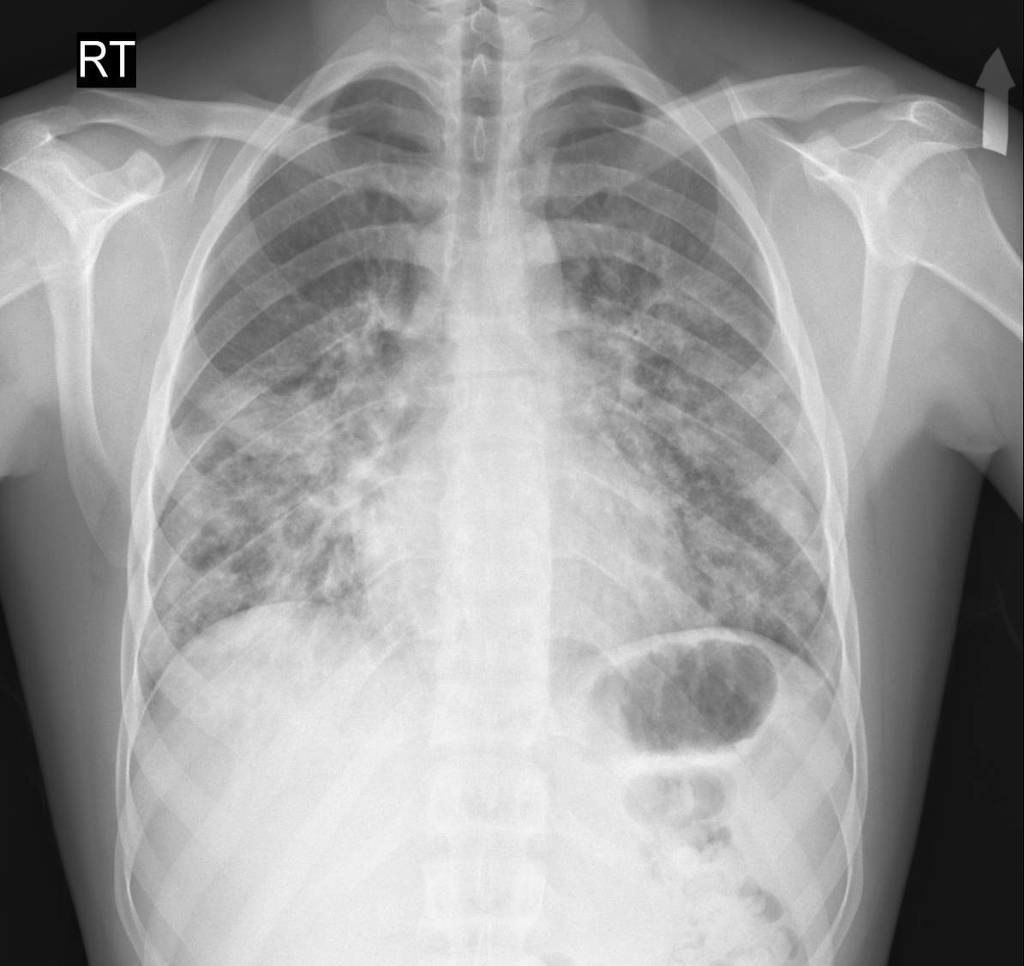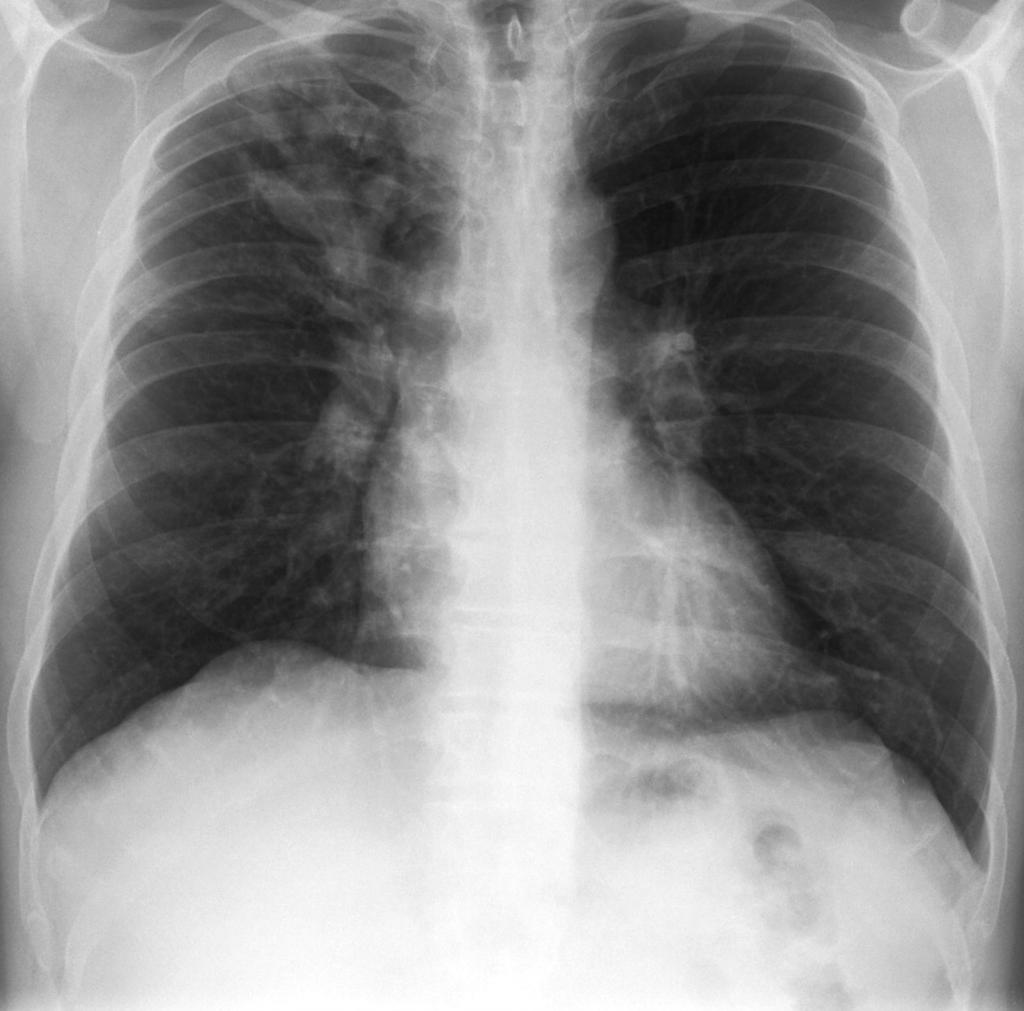Loefflers syndrome chest x ray: Difference between revisions
No edit summary |
|||
| (9 intermediate revisions by the same user not shown) | |||
| Line 4: | Line 4: | ||
{{CMG}}{{AE}}{{Soroush}} | {{CMG}}{{AE}}{{Soroush}} | ||
==Overview== | ==Overview== | ||
==Chest X | A [[Chest X-ray|chest x-ray]] may be helpful in the [[diagnosis]] of Löffler syndrome. Findings on an [[X-rays|x-ray]] suggestive of Löffler syndrome include migratory densities. [[Chest X-ray|Chest x-ray]] usually shows abnormal shadows that can be unilateral or bilateral. Generally, densities are peripheral and present with both interstitial and alveolar pattern (at the same time), they are a few centimeters in diameter, and are transient, migratory, and disappear completely within 2-4 weeks. [[Pleural effusion]]<nowiki/>s is not common in Loeffler syndrome, but there are reports of [[pleural effusion]] in patients with drug-induced pulmonary [[eosinophilia]]. ([[nitrofurantoin]], [[valproic acid]]) | ||
* Chest x-ray usually shows abnormal shadows that can be unilateral or bilateral. | |||
==X Ray== | |||
An [[Chest X-ray|x-ray]] may be helpful in the diagnosis of Löffler syndrome. Findings on an [[X-rays|x-ray]] suggestive of Löffler syndrome include:<ref name="pmid21062596">Te Booij M, de Jong E, Bovenschen HJ (2010) [https://www.ncbi.nlm.nih.gov/entrez/eutils/elink.fcgi?dbfrom=pubmed&retmode=ref&cmd=prlinks&id=21062596 Löffler syndrome caused by extensive cutaneous larva migrans: a case report and review of the literature.] ''Dermatol Online J'' 16 (10):2. PMID: [https://pubmed.gov/21062596 21062596]</ref><ref name="pmid16612768">Chitkara RK, Krishna G (2006) [https://www.ncbi.nlm.nih.gov/entrez/eutils/elink.fcgi?dbfrom=pubmed&retmode=ref&cmd=prlinks&id=16612768 Parasitic pulmonary eosinophilia.] ''Semin Respir Crit Care Med'' 27 (2):171-84. [http://dx.doi.org/10.1055/s-2006-939520 DOI:10.1055/s-2006-939520] PMID: [https://pubmed.gov/16612768 16612768]</ref><ref name="pmid21062596">Te Booij M, de Jong E, Bovenschen HJ (2010) [https://www.ncbi.nlm.nih.gov/entrez/eutils/elink.fcgi?dbfrom=pubmed&retmode=ref&cmd=prlinks&id=21062596 Löffler syndrome caused by extensive cutaneous larva migrans: a case report and review of the literature.] ''Dermatol Online J'' 16 (10):2. PMID: [https://pubmed.gov/21062596 21062596]</ref><ref name="pmid24931460">Ekin S, Sertogullarindan B, Gunbatar H, Arisoy A, Yildiz H (2016) [https://www.ncbi.nlm.nih.gov/entrez/eutils/elink.fcgi?dbfrom=pubmed&retmode=ref&cmd=prlinks&id=24931460 Loeffler's syndrome: an interesting case report.] ''Clin Respir J'' 10 (1):112-4. [http://dx.doi.org/10.1111/crj.12173 DOI:10.1111/crj.12173] PMID: [https://pubmed.gov/24931460 24931460]</ref> <ref name="pmid13480465">Caulet T (1957) [https://www.ncbi.nlm.nih.gov/entrez/eutils/elink.fcgi?dbfrom=pubmed&retmode=ref&cmd=prlinks&id=13480465 [Loffler syndrome and pulmonary eosinophilia].] ''Gaz Med Fr'' 64 (20):1737-8 passim. PMID: [https://pubmed.gov/13480465 13480465]</ref><ref name="pmid5667987">(1968) [https://www.ncbi.nlm.nih.gov/entrez/eutils/elink.fcgi?dbfrom=pubmed&retmode=ref&cmd=prlinks&id=5667987 Löffler's syndrome.] ''Br Med J'' 3 (5618):569-70. PMID: [https://pubmed.gov/5667987 5667987]</ref><ref name="pmid21007279">SASLAW MS, BOWMAN JA (1946) [https://www.ncbi.nlm.nih.gov/entrez/eutils/elink.fcgi?dbfrom=pubmed&retmode=ref&cmd=prlinks&id=21007279 Loeffler's syndrome.] ''J Fla Med Assoc'' 32 ():373. PMID: [https://pubmed.gov/21007279 21007279]</ref><ref name="pmid21025484">SPECTOR HI (1945) [https://www.ncbi.nlm.nih.gov/entrez/eutils/elink.fcgi?dbfrom=pubmed&retmode=ref&cmd=prlinks&id=21025484 Loeffler's syndrome (transient pulmonary infiltrations with eosinophilia); report of a case and a review of the available literature.] ''Dis Chest'' 11 ():380-91. PMID: [https://pubmed.gov/21025484 21025484]</ref><ref name="pmid21010826">GREIG ED (1945) [https://www.ncbi.nlm.nih.gov/entrez/eutils/elink.fcgi?dbfrom=pubmed&retmode=ref&cmd=prlinks&id=21010826 On tropical eosinophilia associated with pulmonary signs (Loeffler's syndrome).] ''J Trop Med Hyg'' 48 ():149-51. PMID: [https://pubmed.gov/21010826 21010826]</ref> | |||
*[[Chest X-ray|Chest x-ray]] usually shows abnormal shadows that can be unilateral or bilateral. | |||
* Generally peripheral densities | * Generally peripheral densities | ||
* Present with both interstitial and alveolar pattern (at the same time). | * Present with both interstitial and alveolar pattern (at the same time). | ||
* Usually a few centimeters in diameter, but larger areas of consolidation are possible | * Usually a few centimeters in diameter, but larger areas of consolidation are possible | ||
* Generally transient, migratory, and disappear completely within 2-4 weeks. | * Generally transient, migratory, and disappear completely within 2-4 weeks. | ||
* [[Pleural effusion]]<nowiki/>s is not common in Loeffler syndrome, but there are reports of [[pleural effusion]] in patients with drug-induced pulmonary eosinophilia. (nitrofurantoin, valproic acid) | *<nowiki/>[[Pleural effusion]]<nowiki/>s is not common in Loeffler syndrome, but there are reports of [[pleural effusion]] in patients with drug-induced pulmonary eosinophilia. (nitrofurantoin, valproic acid) | ||
[[Image:Acute-eosinophilic-pneumonia-1.jpg|thumb|center|400px|Acute eosinophilic pneumonia. Case courtesy of Dr Yair Glick, <a href="https://radiopaedia.org/">Radiopaedia.org</a>. From the case <a href="https://radiopaedia.org/cases/53840">rID: 53840</a>]] | |||
[[Image:Allergic-bronchopulmonary-aspergillosis-6.jpg|thumb|center|400px|'''Allergic bronchopulmonary aspergillosis (ABPA).''' Case courtesy of A.Prof Frank Gaillard, <a href="https://radiopaedia.org/">Radiopaedia.org</a>. From the case <a href="https://radiopaedia.org/cases/15388">rID: 15388</a>]] | |||
==Follow-up== | |||
*4-6 weeks after initial presentation: Repeat chest radiography (document resolution of pulmonary infiltrates) | |||
==References== | ==References== | ||
{{reflist|2}} | {{reflist|2}} | ||
Latest revision as of 14:41, 11 June 2019
|
Löffler's syndrome Microchapters |
|
Diagnosis |
|---|
|
Treatment |
|
Case Studies |
|
Loefflers syndrome chest x ray On the Web |
|
American Roentgen Ray Society Images of Loefflers syndrome chest x ray |
|
Risk calculators and risk factors for Loefflers syndrome chest x ray |
Editor-In-Chief: C. Michael Gibson, M.S., M.D. [1]Associate Editor(s)-in-Chief: Soroush Seifirad, M.D.[2]
Overview
A chest x-ray may be helpful in the diagnosis of Löffler syndrome. Findings on an x-ray suggestive of Löffler syndrome include migratory densities. Chest x-ray usually shows abnormal shadows that can be unilateral or bilateral. Generally, densities are peripheral and present with both interstitial and alveolar pattern (at the same time), they are a few centimeters in diameter, and are transient, migratory, and disappear completely within 2-4 weeks. Pleural effusions is not common in Loeffler syndrome, but there are reports of pleural effusion in patients with drug-induced pulmonary eosinophilia. (nitrofurantoin, valproic acid)
X Ray
An x-ray may be helpful in the diagnosis of Löffler syndrome. Findings on an x-ray suggestive of Löffler syndrome include:[1][2][1][3] [4][5][6][7][8]
- Chest x-ray usually shows abnormal shadows that can be unilateral or bilateral.
- Generally peripheral densities
- Present with both interstitial and alveolar pattern (at the same time).
- Usually a few centimeters in diameter, but larger areas of consolidation are possible
- Generally transient, migratory, and disappear completely within 2-4 weeks.
- Pleural effusions is not common in Loeffler syndrome, but there are reports of pleural effusion in patients with drug-induced pulmonary eosinophilia. (nitrofurantoin, valproic acid)


Follow-up
- 4-6 weeks after initial presentation: Repeat chest radiography (document resolution of pulmonary infiltrates)
References
- ↑ 1.0 1.1 Te Booij M, de Jong E, Bovenschen HJ (2010) Löffler syndrome caused by extensive cutaneous larva migrans: a case report and review of the literature. Dermatol Online J 16 (10):2. PMID: 21062596
- ↑ Chitkara RK, Krishna G (2006) Parasitic pulmonary eosinophilia. Semin Respir Crit Care Med 27 (2):171-84. DOI:10.1055/s-2006-939520 PMID: 16612768
- ↑ Ekin S, Sertogullarindan B, Gunbatar H, Arisoy A, Yildiz H (2016) Loeffler's syndrome: an interesting case report. Clin Respir J 10 (1):112-4. DOI:10.1111/crj.12173 PMID: 24931460
- ↑ Caulet T (1957) [Loffler syndrome and pulmonary eosinophilia.] Gaz Med Fr 64 (20):1737-8 passim. PMID: 13480465
- ↑ (1968) Löffler's syndrome. Br Med J 3 (5618):569-70. PMID: 5667987
- ↑ SASLAW MS, BOWMAN JA (1946) Loeffler's syndrome. J Fla Med Assoc 32 ():373. PMID: 21007279
- ↑ SPECTOR HI (1945) Loeffler's syndrome (transient pulmonary infiltrations with eosinophilia); report of a case and a review of the available literature. Dis Chest 11 ():380-91. PMID: 21025484
- ↑ GREIG ED (1945) On tropical eosinophilia associated with pulmonary signs (Loeffler's syndrome). J Trop Med Hyg 48 ():149-51. PMID: 21010826